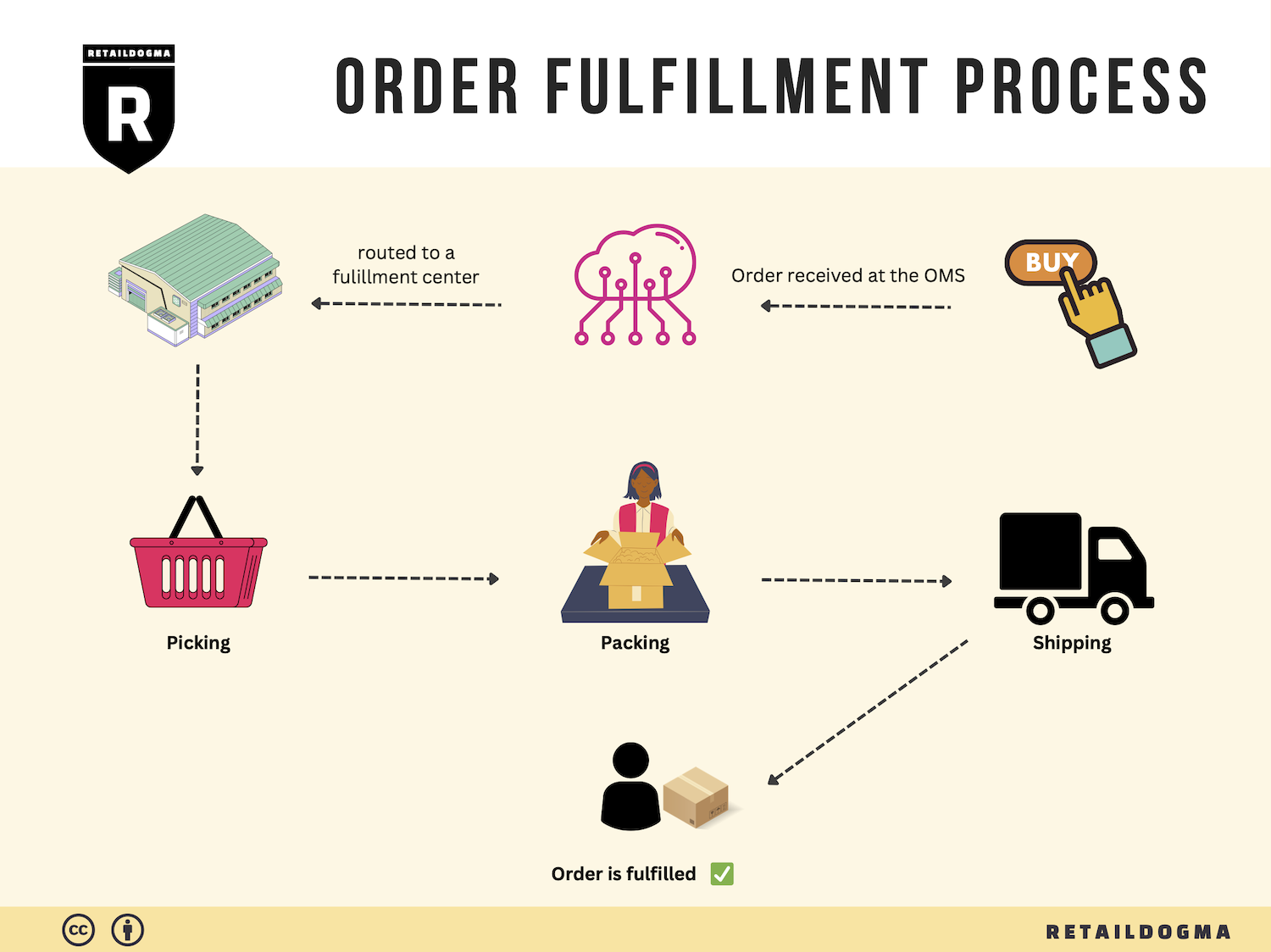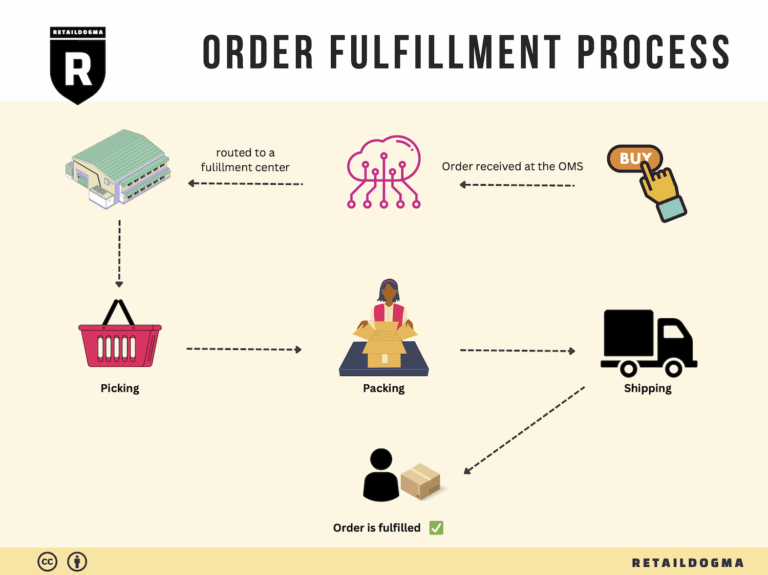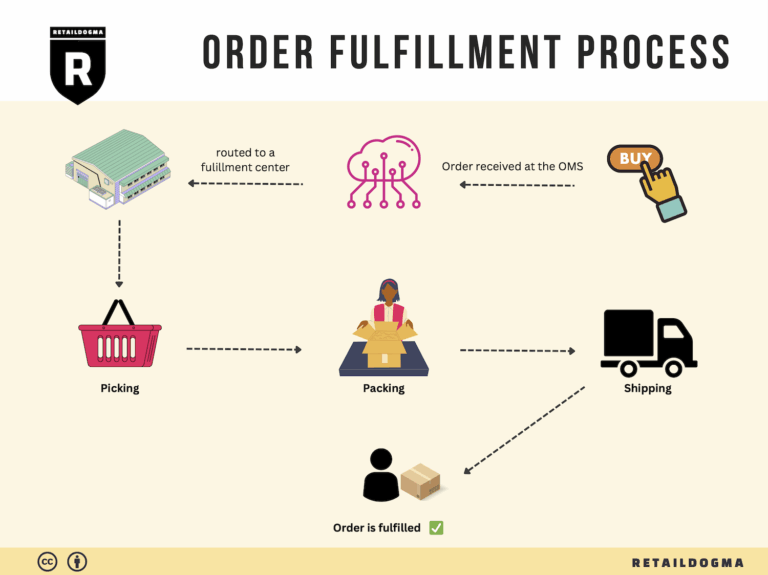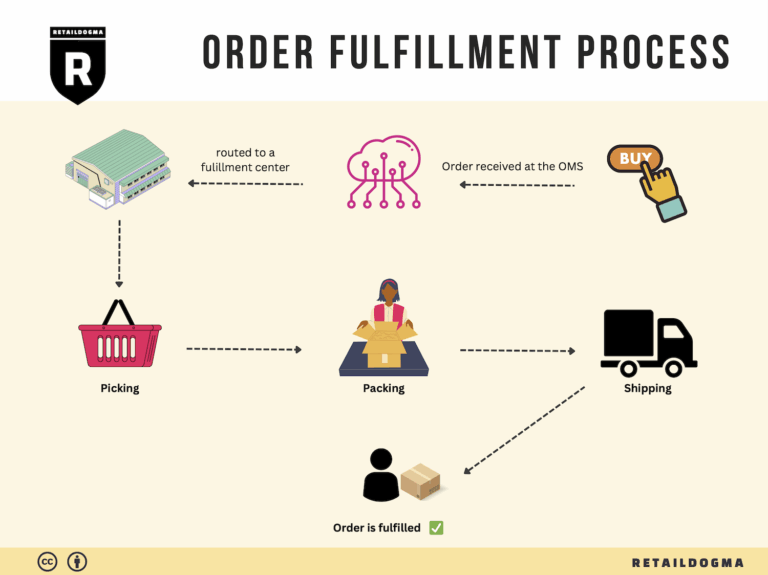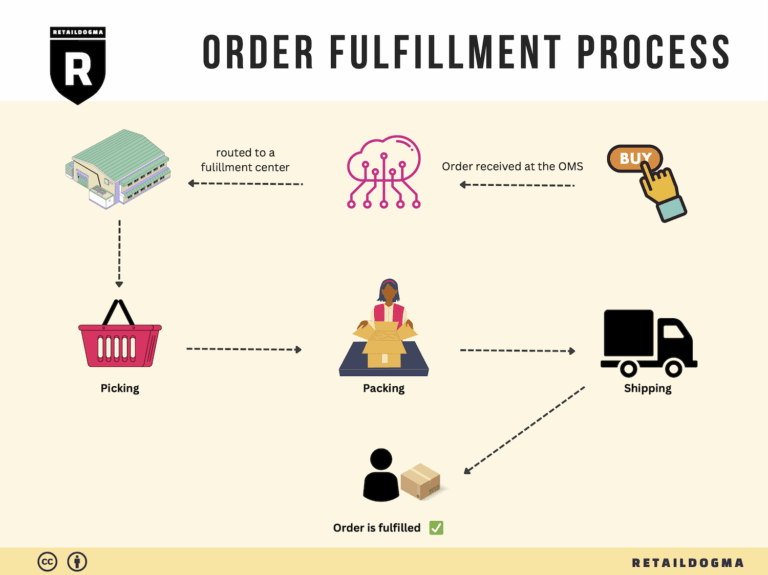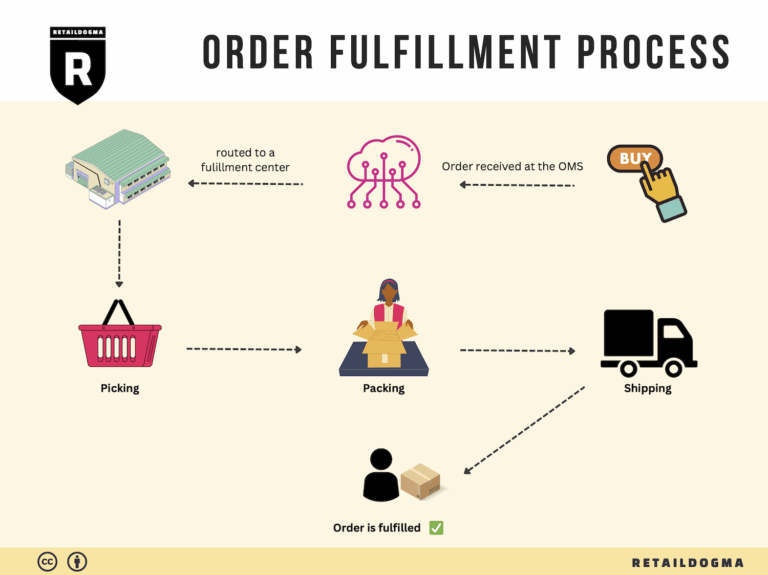Ecommerce Fulfillment Services: The Ultimate Guide (2025)
What is E-commerce Fulfillment? An Introduction for Growing Businesses
Understanding E-commerce Fulfillment: A Critical Component for Growth
As an e-commerce business owner, you may have experienced the daunting task of managing the packing and shipping of orders, especially during peak seasons. The excitement of growing sales can quickly turn into stress when faced with the logistical challenges of fulfilling orders accurately and on time. This is where e-commerce fulfillment comes into play—essentially, it refers to the entire process of getting a product from your warehouse or supplier to your customer’s doorstep.
At its core, fulfillment involves several key steps: receiving orders, picking products from inventory, packing them securely, and shipping them out. This process not only impacts your operational efficiency but also directly influences customer satisfaction. Delays, errors, or poor packaging can lead to negative reviews and lost sales, making it crucial to streamline your fulfillment strategy as you scale your business.
In this guide, we will explore various fulfillment models available to online retailers, including Third-Party Logistics (3PL) and Fulfillment by Amazon (FBA). Each model has its unique advantages and challenges, and understanding these can help you select the best fit for your business needs.
We will delve into the core services typically offered by fulfillment partners, such as inventory management, order processing, and returns handling. Knowing what services to expect can help you set clear expectations and establish a productive relationship with your chosen partner.
Choosing the right fulfillment partner can be a game-changer for your business. We will provide practical criteria to evaluate potential partners, including their operational capabilities, technology integration, and customer service quality.
Finally, we will cover pricing structures commonly associated with e-commerce fulfillment. Understanding the cost implications of different fulfillment options will empower you to make informed financial decisions that align with your growth strategy.
This guide aims to empower e-commerce businesses to make smart, informed choices about their logistics operations. By optimizing your fulfillment process, you can enhance customer experience, reduce operational stress, and ultimately drive growth in your online business.

What You’ll Learn In This Guide
- What is E-commerce Fulfillment? An Introduction for Growing Businesses
- The Order Fulfillment Process: From ‘Buy’ Button to Customer’s Door
- Comparing Fulfillment Models: In-House vs. 3PL vs. Dropshipping
- A Deep Dive into Amazon FBA: Pros, Cons, and Who It’s For
- Core Services Offered by Fulfillment Centers
- How to Choose a Fulfillment Partner: A 6-Point Checklist
- Understanding Fulfillment Pricing: A Breakdown of Common Fees
- Frequently Asked Questions (FAQs) about Fulfillment
- Conclusion: Is Outsourcing Fulfillment the Right Move for Your Business?
- Important Disclaimer
The Order Fulfillment Process: From ‘Buy’ Button to Customer’s Door
1. Receiving Inventory
The order fulfillment process begins with receiving inventory from suppliers. This step involves checking the shipment against the purchase order to ensure that the correct quantities and types of products have been delivered. Key terms associated with this step include SKU (Stock Keeping Unit), which helps in tracking individual items.
Receiving inventory is crucial as it sets the foundation for the entire fulfillment operation. Any discrepancies at this stage—such as damaged goods or incorrect quantities—can lead to issues later in the process, affecting order accuracy and customer satisfaction. By maintaining a systematic approach to receiving, businesses can quickly identify and resolve issues, ensuring that inventory levels are accurately reflected in their systems.
2. Warehouse Storage
Once the inventory is received and verified, the next step is warehouse storage. This involves organizing products in a manner that facilitates easy access and efficient order picking. Effective warehouse management often utilizes slotting, which is the strategic placement of items based on factors like demand and size.
Proper storage is vital for optimizing space and reducing the time spent locating items during the picking phase. It also directly impacts the overall efficiency of the fulfillment process. A well-organized warehouse minimizes the risk of stockouts and overstock situations, which can lead to increased carrying costs and lost sales opportunities. By employing inventory management software, businesses can keep track of stock levels and ensure that items are stored in their designated locations.
3. Order Picking
The order picking stage involves selecting the correct items from storage to fulfill customer orders. This process often utilizes pick lists, which are documents or digital lists that detail the items and quantities needed for each order. There are various picking methods, including single order picking, batch picking, and zone picking, each suited to different operational needs.
Order picking is a critical step as it directly affects order accuracy and delivery speed. Errors made during this phase can lead to incorrect shipments, resulting in customer dissatisfaction and increased return rates. By implementing efficient picking methods and utilizing technology such as barcode scanners, businesses can enhance accuracy and streamline the picking process, ultimately improving customer experience.
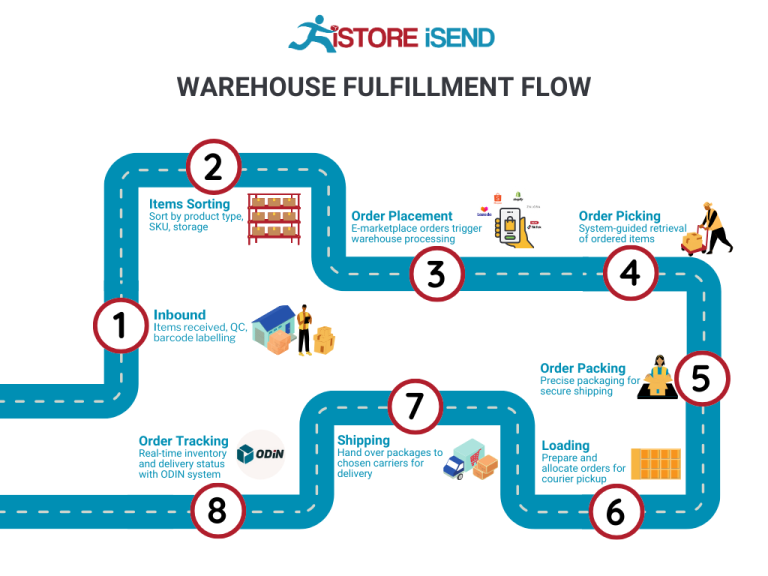
4. Order Packing
After items have been picked, they move to the packing stage. This step includes verifying that the correct items have been selected and then securely packaging them for shipment. Key terms associated with this phase include packing slips, which provide customers with an itemized list of what is included in their order.
Packing is essential for ensuring that products arrive at their destination in good condition. Proper packaging protects items during transit and can prevent damage, which is crucial for maintaining customer satisfaction. Additionally, packing is an opportunity to reinforce branding—using customized packaging can enhance the unboxing experience and leave a lasting impression on customers. Efficient packing processes can reduce shipping costs by minimizing package size and weight, leading to further operational savings.
5. Shipping & Delivery
The final step in the order fulfillment process is shipping and delivery. This involves coordinating with carriers to transport the packaged orders to customers. Key terms associated with this stage include shipping labels, which contain important information for tracking and delivery.
Shipping and delivery are pivotal in defining the customer experience. Timely and accurate delivery directly influences customer satisfaction and repeat business. Businesses must choose the right shipping methods based on cost, speed, and reliability, often utilizing third-party logistics (3PL) providers to streamline this process. Moreover, effective communication with customers regarding order status and tracking information fosters transparency and builds trust. By monitoring shipping performance metrics, businesses can continually improve their logistics strategies, ensuring that they meet customer expectations and enhance operational efficiency.
In conclusion, the order fulfillment process is a multifaceted operation that requires attention to detail at every stage. By understanding and optimizing each step—from receiving inventory to delivering orders—e-commerce businesses can enhance their efficiency, improve customer satisfaction, and ultimately scale their operations effectively.
Comparing Fulfillment Models: In-House vs. 3PL vs. Dropshipping
Fulfillment Models Overview
When it comes to e-commerce fulfillment, choosing the right model can significantly impact operational efficiency, customer satisfaction, and overall business scalability. Below is a comparison of three prevalent fulfillment models: In-House Fulfillment, Third-Party Logistics (3PL), and Dropshipping.
| Model | Who Handles Inventory | Best For (Business Stage) | Key Advantage | Key Disadvantage |
|---|---|---|---|---|
| In-House Fulfillment | The business itself | Startups and established brands | Full control over inventory and processes | High overhead costs and resource requirements |
| Third-Party Logistics (3PL) | 3PL provider handles inventory | Growing and scaling businesses | Cost-effective and scalable logistics solutions | Less control over the fulfillment process |
| Dropshipping | Supplier handles inventory | Startups and niche businesses | Low startup costs and reduced risk | Lower profit margins and reliance on suppliers |
In-House Fulfillment
In-house fulfillment involves managing the entire order processing and shipping process within the company. This model is suitable for startups and established brands that have the resources to invest in warehousing, staff, and logistics technology. By handling inventory directly, businesses maintain complete control over their products, which can enhance quality assurance and customer service. Companies can implement tailored processes that align with their specific operational needs and customer expectations. However, this model comes with significant overhead costs, including rent for warehouse space, salaries for fulfillment staff, and investment in inventory management systems. Moreover, as order volumes grow, businesses may struggle to scale their operations efficiently without additional capital investment.
Third-Party Logistics (3PL)
Third-party logistics (3PL) involves outsourcing fulfillment operations to a specialized provider. This model is ideal for growing and scaling businesses that want to focus on core competencies like marketing and product development rather than logistics. 3PL providers offer a range of services, including warehousing, inventory management, order processing, and shipping. One of the main advantages of using a 3PL is cost-effectiveness; businesses can save on overhead costs associated with maintaining their own warehouse and staff. Additionally, 3PLs often have established relationships with shipping carriers, which can lead to better rates and faster shipping options. However, the downside is that businesses relinquish some control over their fulfillment processes, which can lead to inconsistencies in service quality and customer experience. Clear communication and regular performance assessments are essential to mitigate these risks.
Dropshipping
Dropshipping is a fulfillment model where the retailer does not keep goods in stock but instead transfers customer orders directly to a supplier, who then ships the products to the customer. This model is particularly attractive for startups and niche businesses with limited capital, as it requires minimal upfront investment and eliminates the need for inventory management. Retailers can offer a wide range of products without the risk of unsold stock. However, dropshipping has its challenges; profit margins can be lower due to reliance on suppliers for fulfillment, and businesses face potential delays in shipping or product quality issues that are beyond their control. Additionally, managing customer expectations can be tricky, especially if suppliers have long lead times or inconsistent inventory levels. For businesses considering dropshipping, building strong relationships with reliable suppliers is crucial to ensure a smooth fulfillment process.
Conclusion
Choosing the right fulfillment model is a critical decision for e-commerce businesses. Each model—In-House Fulfillment, 3PL, and Dropshipping—offers distinct advantages and challenges. Business owners must assess their current operational capabilities, growth objectives, and customer expectations to determine which model best aligns with their strategic goals. By understanding the nuances of each fulfillment approach, e-commerce businesses can optimize their logistics operations, enhance customer satisfaction, and ultimately drive growth in a competitive marketplace.
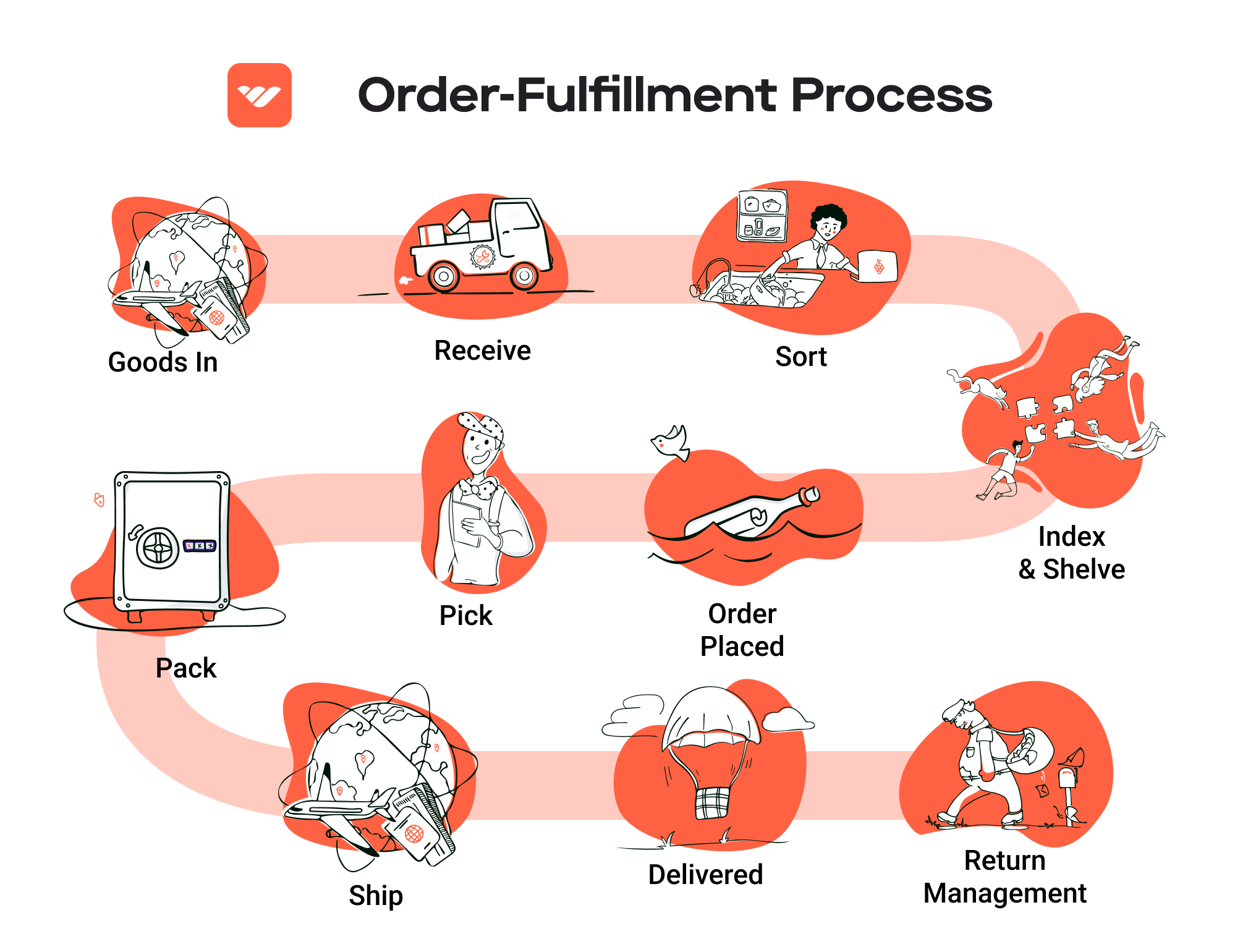
A Deep Dive into Amazon FBA: Pros, Cons, and Who It’s For
Understanding Fulfillment by Amazon (FBA)
Fulfillment by Amazon (FBA) is a service provided by Amazon that allows sellers to store their products in Amazon’s fulfillment centers. Amazon takes care of storage, packaging, and shipping of products directly to customers. This service offers a seamless experience for both sellers and buyers, enabling sellers to focus on growing their business while Amazon handles the logistics.
How FBA Works
-
Product Listing: Sellers create product listings on Amazon, and during the setup, they can opt to use FBA. This integration allows sellers to take advantage of Amazon’s extensive logistics network.
-
Shipping to Amazon: Sellers ship their products to Amazon’s fulfillment centers. Amazon provides guidelines on how to package and label products to ensure they are processed correctly upon arrival.
-
Storage: Once the products are received, they are stored in Amazon’s warehouse. Sellers can monitor their inventory through the Seller Central dashboard.
-
Order Fulfillment: When a customer places an order, Amazon picks, packs, and ships the product on behalf of the seller. This process typically includes using Amazon’s advanced logistics technology to optimize shipping routes and delivery times.
-
Customer Service: Amazon also handles customer service and returns for FBA orders, providing sellers with additional support.
-
Payment: After the order is fulfilled, sellers receive payment, minus Amazon’s fees for using the FBA service.
Pros of Using FBA
1. Prime Eligibility
One of the significant advantages of using FBA is that products become eligible for Amazon Prime. This feature not only attracts Prime members but also enhances the likelihood of sales due to the appeal of free two-day shipping.
2. Enhanced Customer Trust
Products fulfilled by Amazon tend to have higher trust levels among customers. Shoppers feel more secure purchasing from sellers who use FBA, knowing that Amazon guarantees timely delivery and customer service support.
3. Multi-Channel Fulfillment
FBA is not limited to Amazon sales alone. Sellers can use FBA to fulfill orders from other channels, such as their own websites or eBay, allowing for a streamlined fulfillment process across multiple platforms.
4. Simplified Logistics
FBA takes the burden of logistics off sellers’ shoulders. By outsourcing storage, packing, and shipping to Amazon, sellers can focus on other aspects of their business, such as marketing and product development.
5. Scale with Ease
As a seller grows, FBA provides the scalability needed to handle increased order volumes without the need for additional warehousing or logistics infrastructure.
Cons of Using FBA
1. High Fees
While FBA offers numerous benefits, it comes at a cost. Sellers must pay various fees, including storage fees for holding inventory and fulfillment fees for picking, packing, and shipping orders. These costs can add up, particularly for low-margin products.
2. Strict Inventory Rules
Amazon has stringent inventory management policies that sellers must adhere to. This includes requirements for labeling and packaging, as well as limitations on the types of products that can be sold. Failure to comply can lead to penalties or account suspensions.
3. Commingling Risks
FBA uses a commingling system where inventory from different sellers is stored together. This can lead to issues where products may be shipped to customers that do not belong to a seller, potentially resulting in negative feedback or returns if the product is not what the customer expected.
4. Loss of Control
By relying on Amazon for fulfillment, sellers may lose some control over their customer experience. Issues such as shipping delays or damaged products can reflect poorly on the seller, even if they are due to Amazon’s handling.
5. Limited Branding Opportunities
FBA packages are typically unbranded, which means that sellers miss out on the opportunity to create a unique unboxing experience for their customers. This can be a disadvantage for brands looking to establish a strong identity.
Who is FBA Best For?
Fulfillment by Amazon is best suited for a variety of sellers, but particularly for:
-
Small to Medium-Sized Businesses: Businesses that do not have the capacity to manage their own logistics can benefit greatly from the efficiency and scalability of FBA.
-
E-commerce Entrepreneurs: New sellers looking to quickly establish their presence in the marketplace can leverage FBA’s infrastructure to gain customer trust and visibility.
-
High-Volume Sellers: Businesses that sell high volumes of products can take advantage of FBA’s capabilities to handle large orders efficiently.
-
Sellers with Low-Margin Products: While FBA fees can be high, sellers with low-margin products can still benefit from the increased sales velocity and Prime eligibility.
-
Brands Seeking Expansion: Established brands looking to expand their reach can utilize FBA to tap into Amazon’s vast customer base without investing heavily in logistics.
In conclusion, Fulfillment by Amazon offers a robust solution for many e-commerce sellers looking to scale their operations. By weighing the pros and cons, businesses can make informed decisions about whether FBA aligns with their operational goals and customer service standards.
Core Services Offered by Fulfillment Centers
Inventory Management & Warehousing
Inventory management and warehousing form the backbone of any successful e-commerce operation. Fulfillment centers provide sophisticated inventory management systems that help businesses maintain optimal stock levels, track product availability, and minimize the risk of stockouts or overstocking. These systems often integrate seamlessly with e-commerce platforms, allowing real-time updates and visibility into inventory levels.
Benefits for E-commerce Businesses:
1. Improved Accuracy: Automated inventory tracking reduces human error, ensuring that product counts are accurate and up-to-date.
2. Cost Efficiency: By optimizing stock levels, businesses can reduce holding costs and avoid the pitfalls of excess inventory, which ties up capital.
3. Scalability: As businesses grow, fulfillment centers can accommodate increased inventory needs without requiring additional investment in warehouse space or staffing.
Pick and Pack Services
Pick and pack services are essential to the order fulfillment process. This service involves selecting (picking) the ordered products from inventory and packing them for shipment. Fulfillment centers employ skilled staff and efficient technology to ensure that the right products are picked and packaged according to specific customer requirements.
Benefits for E-commerce Businesses:
1. Speed: Fulfillment centers can process orders more quickly than in-house teams, enabling faster delivery to customers and enhancing satisfaction.
2. Customization: Many fulfillment centers offer customized packing options, including branded packaging or special instructions, allowing businesses to enhance their brand identity.
3. Reduced Labor Costs: Outsourcing pick and pack services can significantly reduce labor costs associated with hiring, training, and managing warehouse staff.
Kitting and Assembly
Kitting and assembly is a value-added service where fulfillment centers combine multiple products into a single package or kit. This service is particularly beneficial for e-commerce businesses that sell bundled products or require assembly of items before shipping. For instance, a business selling a DIY furniture kit would benefit from kitting services to ensure that all necessary parts are packaged together.
Benefits for E-commerce Businesses:
1. Enhanced Customer Experience: By providing products in ready-to-use kits, businesses can improve customer satisfaction and reduce the likelihood of returns due to missing parts.
2. Streamlined Operations: Kitting services allow businesses to simplify their inventory management by consolidating multiple SKUs into one, making stock tracking easier.
3. Marketing Opportunities: Bundled products can be marketed at a premium, increasing average order value and encouraging upsells.
Returns Management (Reverse Logistics)
Returns management, often referred to as reverse logistics, is the process of handling returned products efficiently. Fulfillment centers offer comprehensive returns management services that include processing returns, restocking items, and managing customer communications regarding returns. This service is crucial for e-commerce businesses, as an effective returns process can significantly impact customer satisfaction and brand loyalty.
Benefits for E-commerce Businesses:
1. Customer Retention: An efficient returns process can turn a negative experience into a positive one, enhancing customer loyalty and encouraging repeat purchases.
2. Cost Savings: By streamlining the returns process, businesses can reduce costs associated with returns handling and inventory management.
3. Data Insights: Fulfillment centers often provide analytics on return trends, allowing businesses to identify issues with products or fulfillment processes and make informed decisions for improvement.
Conclusion
Utilizing the core services offered by fulfillment centers can significantly enhance the operational efficiency and customer satisfaction of e-commerce businesses. By outsourcing inventory management, pick and pack services, kitting, and returns management, businesses can focus on scaling their operations, improving their marketing strategies, and ultimately driving sales growth. As e-commerce continues to evolve, partnering with a reliable fulfillment center is a strategic move that can provide a competitive edge in a crowded marketplace.
How to Choose a Fulfillment Partner: A 6-Point Checklist
Location & Warehouse Network
Importance: The geographical location of your fulfillment partner’s warehouses can significantly impact shipping times, costs, and customer satisfaction. A strategically placed network can help reduce shipping distances, leading to faster delivery and lower shipping costs.
Questions to Ask:
– Where are your warehouses located, and how do they align with our target customer base?
– Do you have multiple locations to ensure coverage across key regions?
– How do you manage shipping logistics to ensure timely deliveries, especially during peak seasons?
Technology & Integrations
Importance: In today’s e-commerce landscape, having a seamless technology stack is essential for efficient operations. Your fulfillment partner should offer robust technology solutions that integrate smoothly with your e-commerce platform, inventory management systems, and customer relationship management tools.
Questions to Ask:
– What technology platform do you use for order management, and how does it integrate with popular e-commerce systems (like Shopify, WooCommerce, etc.)?
– Can you provide real-time inventory tracking and order status updates?
– How do you ensure data security and privacy in your technology solutions?
Specializations (e.g., Cold Storage, Oversized Items)
Importance: Depending on your product offerings, you may require specialized services. For instance, if you sell perishable goods, your partner must have proper cold storage facilities. If you deal with oversized items, your partner should have the capacity and expertise to handle such products efficiently.
Questions to Ask:
– What types of products do you specialize in handling, and do you have the necessary facilities (e.g., temperature-controlled storage)?
– Can you accommodate unique packaging requirements for our products?
– Have you managed similar products in the past, and what were the outcomes?
Scalability & Capacity
Importance: As your business grows, your fulfillment needs will change. A good partner should have the capacity to scale operations up or down based on your business cycle, ensuring you can meet customer demand without overcommitting resources.
Questions to Ask:
– How do you handle sudden spikes in order volume (e.g., during holidays or sales events)?
– What is your maximum capacity for order fulfillment, and how quickly can you scale operations if needed?
– Can you provide case studies or examples of how you’ve successfully scaled for other clients?
Pricing and Contracts
Importance: Understanding the pricing structure and contract terms is critical to avoid unexpected costs. Look for transparency in pricing, including setup fees, storage costs, shipping rates, and potential surcharges.
Questions to Ask:
– Can you provide a detailed breakdown of your pricing model, including any hidden fees?
– What are your contract terms, and is there flexibility for renegotiation based on performance or changing needs?
– Do you offer volume discounts, and how do you handle pricing for international shipments?
Customer Support & Reviews
Importance: Reliable customer support is crucial for resolving issues quickly and efficiently. Additionally, researching reviews and testimonials from other clients can provide insights into the fulfillment partner’s reliability and service quality.
Questions to Ask:
– What customer support channels do you offer (e.g., phone, email, chat), and what are your response times?
– How do you handle customer complaints or fulfillment errors?
– Can you provide references or case studies from current or past clients that highlight your customer service capabilities?
Conclusion
Choosing the right fulfillment partner is a vital step in scaling your e-commerce business. By carefully evaluating potential partners against this checklist, you can make an informed decision that aligns with your operational needs and growth objectives. Taking the time to address each point will help ensure a smooth fulfillment process that enhances customer satisfaction and drives your business forward.
Understanding Fulfillment Pricing: A Breakdown of Common Fees
Initial Setup Fees
Initial setup fees are often the first costs incurred when partnering with a fulfillment provider. These fees can vary significantly based on the complexity of your operation and the services you require. Typically, these fees cover the costs associated with onboarding your business, which may include:
- Account setup: Creating your account and integrating your e-commerce platform with the fulfillment center’s systems.
- Inventory setup: Registering your products in their inventory management system, which may involve categorizing items, assigning SKUs, and inputting product details.
- Warehouse preparation: Modifications or enhancements to the storage area to accommodate your specific inventory needs, such as specialized shelving or temperature-controlled environments.
These fees can range from a few hundred to several thousand dollars, depending on the scale of your operations and the level of customization needed.
Receiving Fees
Receiving fees are charged when your inventory arrives at the fulfillment center. These fees cover the labor and resources required to unload, inspect, and store your products. The calculation of receiving fees typically involves:
- Per unit charge: Some fulfillment providers charge a fee based on the number of units received. For example, a center might charge $0.50 per item unloaded and processed.
- Minimum fees: In cases where your shipments are small, fulfillment centers may impose a minimum receiving fee to ensure that the cost of processing is covered.
It’s important to clarify how the fulfillment center defines a “unit,” as this can differ based on product size and type.
Storage Fees (per pallet/bin)
Storage fees are ongoing costs associated with keeping your inventory in the fulfillment center. These fees can be calculated in several ways:
- Per pallet: Many fulfillment centers charge based on the number of pallets your products occupy. This can be beneficial for businesses with bulk items but may become costly if your inventory is spread across many small items.
- Per bin: For smaller items, fulfillment centers may utilize shelving bins, charging based on the number of bins occupied. This model is often more suitable for e-commerce businesses with a diverse range of products.
- Monthly or quarterly: Storage fees are typically charged on a monthly or quarterly basis, so understanding your inventory turnover rate is crucial to managing these costs effectively.
Pick & Pack Fees (per item/order)
Pick and pack fees cover the labor involved in selecting items from inventory and preparing them for shipment. These fees can be structured in various ways:
- Per item: Some fulfillment providers charge a fee for each item picked, which can range from $0.20 to $2.00 depending on the complexity of the pick.
- Per order: Alternatively, a flat fee may be charged for each order processed, regardless of the number of items included. This is often more cost-effective for orders with multiple items.
- Additional services: If special packing requirements are needed (e.g., gift wrapping, custom packaging), additional fees may apply. Always inquire about these potential costs upfront.
Shipping Fees
Shipping fees are one of the most significant costs in the fulfillment process and can vary widely based on several factors:
- Carrier rates: Costs depend on the shipping carrier used (e.g., UPS, FedEx, USPS) and the service level selected (standard, expedited, etc.). Fulfillment centers often have negotiated rates with carriers, which can benefit businesses.
- Weight and dimensions: Shipping fees are typically calculated based on the weight and size of the package. Dimensional weight pricing may apply, meaning larger but lighter packages could incur higher charges.
- Destination: Shipping costs also vary based on the destination, with longer distances typically incurring higher fees. Some fulfillment providers offer zone-based pricing that can help businesses estimate costs more accurately.
Tips for Getting an Accurate Quote
To obtain an accurate quote for fulfillment services, consider the following steps:
- Provide detailed information: Share specifics about your product types, expected order volumes, and any special requirements you may have. This allows fulfillment centers to give you a more tailored quote.
- Ask for a breakdown: Request a detailed breakdown of all fees associated with their services. This transparency helps you understand where costs are incurred.
- Compare multiple providers: Don’t settle for the first quote you receive. Comparing quotes from multiple fulfillment centers can help you identify the best value for your needs.
- Inquire about discounts: Some fulfillment centers offer discounts for long-term contracts or high-volume shipping. Make sure to ask about these options.
- Review contract terms: Carefully review the terms of service to understand any potential additional fees that may not be included in the initial quote.
By understanding these common fulfillment pricing models and taking proactive steps to gather accurate quotes, e-commerce businesses can better manage their logistics costs and optimize their fulfillment strategies.
Frequently Asked Questions (FAQs) about Fulfillment
1. What is the role of a fulfillment specialist in e-commerce?
A fulfillment specialist manages the entire order fulfillment process, which includes receiving, processing, packing, and shipping products to customers. They ensure that orders are accurate and delivered on time while also handling customer inquiries related to shipping and returns.
2. What’s the difference between a warehouse and a fulfillment center?
A warehouse is primarily a storage facility where goods are kept until they are needed, while a fulfillment center is a specialized type of warehouse designed for order fulfillment. Fulfillment centers focus on efficient processing of orders, including picking, packing, and shipping, often integrating advanced technology to optimize these processes.
3. What is a 3PL (Third-Party Logistics)?
A 3PL is a service provider that manages logistics and supply chain operations for businesses. This includes warehousing, inventory management, order fulfillment, and shipping. Companies often partner with 3PLs to leverage their expertise and resources, allowing them to focus on core business activities.
4. How much do fulfillment services cost?
Fulfillment service costs can vary widely based on several factors, including order volume, storage space required, shipping methods, and additional services like packing and handling. Generally, businesses can expect to pay a per-order fee, monthly storage fees, and shipping costs, which can range from a few dollars to several tens of dollars per order depending on the complexity.
5. How can I improve my order fulfillment efficiency?
To enhance order fulfillment efficiency, consider implementing inventory management software, optimizing warehouse layout for faster picking, training staff regularly, and analyzing key performance metrics to identify bottlenecks. Automating certain processes, such as label printing and shipping, can also significantly reduce fulfillment time.
6. What are the key skills required for a fulfillment specialist?
Key skills for a fulfillment specialist include strong organizational abilities, attention to detail, proficiency in inventory management systems, effective communication skills, and problem-solving capabilities. Familiarity with e-commerce platforms and logistics processes is also essential.
7. How do fulfillment specialists handle returns?
Fulfillment specialists manage returns by processing return requests, inspecting returned items for damage, updating inventory records, and issuing refunds or exchanges as necessary. They must ensure that the return process is efficient to maintain customer satisfaction and minimize losses.
8. What technology is commonly used in fulfillment operations?
Common technologies in fulfillment operations include warehouse management systems (WMS), inventory management software, order management systems (OMS), and shipping software. Automation tools, such as barcode scanners and conveyor belts, are also used to streamline picking and packing processes.
9. How does customer service play a role in fulfillment?
Customer service is crucial in fulfillment as it directly impacts customer satisfaction. Fulfillment specialists must effectively communicate with customers about order status, handle inquiries or complaints, and provide timely resolutions. A positive customer service experience can lead to repeat business and customer loyalty.
10. What are some common challenges faced in order fulfillment?
Common challenges in order fulfillment include inventory inaccuracies, shipping delays, managing returns, and maintaining high order accuracy rates. Additionally, fluctuations in order volume, especially during peak seasons, can strain fulfillment operations. Implementing robust systems and processes can help mitigate these challenges.
Conclusion: Is Outsourcing Fulfillment the Right Move for Your Business?
Evaluating the Advantages of Outsourcing Fulfillment
Outsourcing fulfillment can be a transformative decision for e-commerce businesses aiming to scale. One of the most significant benefits is time savings. By partnering with a fulfillment service, you can offload the labor-intensive processes of receiving, processing, packing, and shipping orders. This allows you to redirect your focus toward strategic initiatives like marketing and product development, ultimately enhancing your business growth.
Scalability is another compelling reason to consider outsourcing. As your sales volume fluctuates, fulfillment services can easily adjust to meet demand without the need for substantial investments in infrastructure or personnel. This flexibility ensures that your operations can efficiently handle peak seasons and unexpected spikes in orders, maintaining customer satisfaction and loyalty.
Moreover, fulfillment specialists bring a wealth of expertise to the table. They are well-versed in the complexities of logistics, inventory management, and shipping regulations. Their experience can lead to improved operational efficiency, reduced errors, and faster delivery times, which are critical factors in today’s competitive e-commerce landscape.
However, the effectiveness of outsourcing hinges on selecting the right fulfillment partner. A thorough evaluation of potential providers is essential to ensure they align with your business goals and can accommodate your specific needs. Look for partners who demonstrate a robust understanding of e-commerce, provide transparent communication, and offer scalable solutions.
Call to Action
To determine if outsourcing fulfillment is the right next step for your business, conduct an audit of your current shipping processes. Assess your time investment, operational costs, and customer satisfaction levels. This analysis will help you identify gaps and opportunities for improvement, guiding you toward a fulfillment strategy that can support your growth ambitions. Take the leap towards efficiency and enhanced customer experience—your future self will thank you.
Important Disclaimer
⚠️ Important Disclaimer
The information in this guide is for educational purposes. Fulfillment services, pricing, and platform features change frequently. Always conduct your own due diligence and consult with providers directly before making business decisions.
